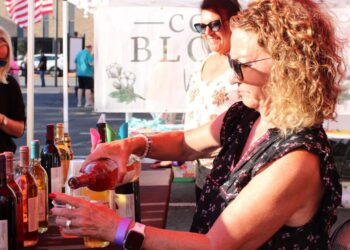Finally some good rains that might help our lakes come back up, and some 90-degree days gets one thinking about heading to the lake.
With school finishing up this week, the local boat ramp will see an increase of business.
And that’s where the fun of a lake trip can go south in a hurry!
Just sit near an urban boat ramp on a busy weekend and you’ll witness a comedy of launch and retrieval boating errors that would be funny if not for the bottleneck that trickles down to other boaters.
Visit enough ramps and you’ll eventually see a towing vehicle submerged off the end of the ramp or a boat driven over a trailer into the bed of a pickup truck. At the very least, you might witness threats and a possible fistfight among frustrated boaters waiting to launch.
Here’s a checklist to keep angry glares to a minimum and maximize the pleasure that should be the reason for any boating experience:
Practice makes perfect — Practice backing your boat trailer until you can accomplish the task with ease.
A crowded ramp is no place to learn how to back a trailer. Those practice sessions should take place in a large, empty parking lot. It helps if you have traffic cones or other mobile barriers that can be placed about the right distance apart to simulate the width of a launch ramp.
If you haven’t launched a boat since last year, a practice session is definitely in order.
Battery check — Long before you tow your boat to the water, make certain the battery is charged and all working parts are functional. Don’t park on a ramp, then turn the key for the first time in months and be surprised by a dead battery.
If such a catastrophe does occur, immediately remove your boat from the ramp and allow others to launch. It’s called a launch ramp, not a repair ramp or a maintenance ramp.
Safety first — Before heading for the lake, check your boat to make certain it contains all necessary safety equipment, including a Coast Guard-approved flotation device for everyone aboard.
Also make sure all the required safety equipment is on board before heading to the lake. Those items include: Numbers and decals in good shape, PFDs required, Throw PFD, fire extinguisher, sound device (horn, whistle or bell), lights.
If you plan on skiing, load your skis and tow rope into the boat before you leave home. The same applies to ice chests, fishing tackle, etc. Do not park on the ramp, then move your gear from the towing vehicle to the boat. Make certain the drain plug is firmly in place before the launch.
If you drive an economy-type towing vehicle, pick your boat ramp carefully. A small, underpowered (for towing) car may have trouble pulling a boat up a steep, slick ramp.
Launching into the water — Launching works best if you have at least two experienced people involved. One person gets in the boat while the other person stays in the vehicle and backs the boat down the ramp. When the boat is deep enough in the water, start the engine while it’s still on the trailer and use the engine to ease the boat off the trailer. Your driver may have to back down a little farther to help this process.
Back the boat out away from the ramp while your partner parks the towing vehicle, then slowly approach the ramp, which ideally has a dock, and pick up your partner.
Getting the boat out of the water — Retrieving the boat from the water is essentially a reversal of the launching process and should be equally well thought out. Once the boat is secured to the trailer, pull it out of the water and out of the launch ramp traffic flow. Only then should you attempt to unload gear from the boat and tie it down on the trailer.
Just following these few courtesy tips will make everyone at the local boat ramp much happier, and that is the reason we head to the lake, right?
Lifejackets save lives
It’s too hot! It doesn’t look cool. I know how to swim. Nothing is going to happen to me.
These are just some of the many reasons people claim that they do not wear their life jackets. But with approximately 700 people drowning each year from recreational boating accidents, it is imperative for you to wear your life jacket at all times while you are on the water.
Life jackets are no longer the orange, hot and bulky vests that are commonly associated with on the water safety gear. New innovations and developments in life jackets have produced a smaller, sleeker, and much more comfortable version of a life jacket, leaving you with no reason not to wear it.
May 20-26 is National Safe Boating Wee, and this year’s slogan is to just Wear It! And as they kick off the summer season this Memorial Day, they encourage you to do what it takes to remain safe on the water.
To better promote this May 19, has been declared Wear Your Life Jacket at Work Day. Whether you’re working in the office, at home, in the air, or on the water, all boating enthusiasts can participate in on Friday, this fun day is part of the Safe Boating Campaign, a global awareness effort that encourages boaters to make the most of their boating adventure by being responsible.
“Wear Your Life Jacket at Work Day is a great opportunity to share with others your love for boating,” said Yvonne Pentz, communications director of the National Safe Boating Council, a nonprofit dedicated to helping create a safe boating experience for all boaters and the lead organization of the Safe Boating Campaign.
Here is how to participate – 1. Wear a life jacket wherever you work. 2. Snap a picture
3. Post the picture on social media with the hashtag #wearyourlifejacketatworkday
4. Tag the Safe Boating Campaign (@boatingcampaign)
Much like a helmet to a biker or skate boarder, life jackets are an essential part of your boating safety equipment and should be worn at all times while on the water.
In 2021 of the 658 recreational boating fatalities 85% of those victims not wearing their life jackets. Life jackets are now lighter, less obtrusive and more attractive than ever before. The new inflatable life jackets or Personal Flotation Devices (PFDs) allows you the mobility and flexibility that you need when boating, fishing, paddling or hunting and are much cooler in the warmer weather.
There are many different varieties of inflatable jackets ranging from those that inflate instantly when you hit the water to those that are manually inflated. All are designed to be more comfortable and wearable than the traditional life jacket.
Accidents can happen at an alarming speed anyplace or anytime you are on the water. Although many boaters stow life jackets on their boat, very few choose to wear it. There just isn’t time to grab a life jacket and put it on properly before you are in the water. If you are faced with a strong current or unfavorable weather conditions you will not only have trouble making sure you are safe and secure in your life jacket, but you will be unable to help your friends, relatives, children or passengers that have accompanied you in your boat. Wearing your life jacket will allow you to be safe in case of an accident and will also allow you the ability to assist others that may be in danger
This year, during National Safe Boating Week, and throughout the boating season remember to practice safe and responsible boating, always wear your life jacket, and be alert and aware while on the water.
By practicing these simple steps you can save your life as well as the lives of the people boating with you.
Life jackets are now more comfortable and lightweight than ever, with many new styles to fit the style you want.
Safe boating saves lives so for this year’s National Safe Boating Week and throughout the boating season remember to Boat Smart. Boat Safe. WEAR IT!
Southwest Fishing Report
Altus-Lugert: Elevation 23 ft. below normal, water 70 and stained. Fishing activity slow.
Ellsworth: Elevation 3.5 ft. below normal, water 64 and murky. Crappie good on jigs, minnows around brush, docks and rocks. Saugeye good on crankbaits and small lures main lake points. Catfish fari on liver, punch bait and shad main lake flats and points.
Fort Cobb: Elevation 1 ft. below normal, water 65 and stained. Catfish fair on cut bait, live bait around main lake.
Lawtonka: Elevation 4 ft. below normal, water 65 and clear. Crappie goos on jigs, minnows around brush, structure. Saugeye good on crankbaits and small lures in main lake.
Tom Steed: Elevation 6 ft. below normal and falling, water 68 and murky. Crappie good on jigs, minnows around brush, rocks and shallows. Catfish good on cut bait, punch bait and stinkbait on flats and rocks. Sand bass, hybrids and saugeye good on crankbaits, jigs, minnows and shrimp on main lake pints rock and shorelines.
Waurika: Elevation normal, water 75 and murky. Hybrids and sand bass goos on flukes, sassy shad around main lake points. Largemouth bass good around docks and rocks. Catfish fair on cut bait, shad, stinkbait around main lake points, creek channels and rocks.
Want to reach a local audience and grow your business?
Our website is the perfect platform to connect with engaged readers in your local area.
Whether you're looking for banner ads, sponsored content, or custom promotions, we can tailor a package to meet your needs.
Contact us today to learn more about advertising opportunities!
CONTACT US NOW






